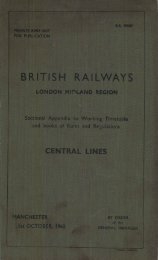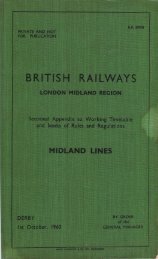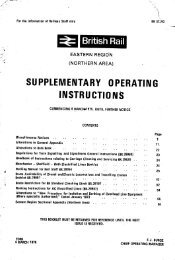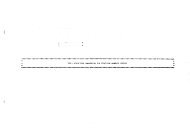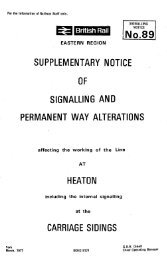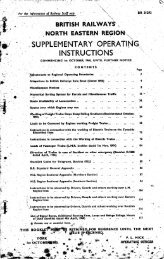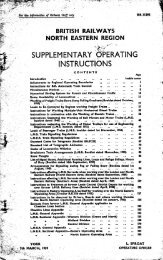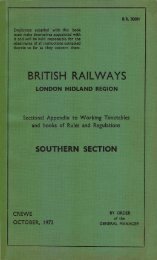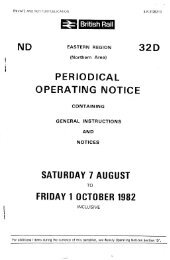general instructions. - Limit Of Shunt
general instructions. - Limit Of Shunt
general instructions. - Limit Of Shunt
Create successful ePaper yourself
Turn your PDF publications into a flip-book with our unique Google optimized e-Paper software.
General Instructions.—Continued. 6 7<br />
Instructions for Protection of Carriage Cleaners, etc.—Continued.<br />
12.—Carriage Cleaners and others must not pass under, over, or between<br />
the buffers of vehicles, nor between the stop blocks and the nearest vehicle,<br />
when less than a carriage length apart. When necessary, men may pass<br />
through a van or THIRD class compartment, but must take care to close<br />
and fasten the doors after them.<br />
13.—Carriage Cleaners and others are strictly forbidden to STAND on<br />
the lines between vehicles or between a vehicle and the stop block unless<br />
they are properly protected in accordance with the above <strong>instructions</strong>.<br />
14.—The attention of the staff concerned is specially directed to Rule 21<br />
in the Book of Rules and Regulations.<br />
1.5.—Where women are employed, the same <strong>instructions</strong> will apply to<br />
them as to men.<br />
NOTE.—The Instructions in regard to placing a red flag at the end of<br />
each train do not apply in the case of through trains, but if it is necessary<br />
for any of the men concerned to carry out work on these trains, they must<br />
inform the Station Master or other person responsible for despatching the<br />
train, who must see that great care is taken in attaching any vehicles to<br />
the train, and must not start it until he is satisfied. that the men have<br />
ceased from working on the train, as set out in General Rule 107.<br />
(O. 9986).<br />
INSTRUCTIONS TO BE OBSERVED FOR THE PROTECTION OF BRAKE<br />
FITTERS, LIFTERS, REPAIRERS AND OTHERS WORKING<br />
ON CARRIAGE OR WAGON STOCK.<br />
General Rules 108 (a), 21, 107, and 112 (a).<br />
These <strong>instructions</strong> must be observed by the Employees of Private<br />
Wagon Repairing Firms as well as by the Railway Staff.<br />
(A)—In Repairing Shop Sidings, and Sidings specially set apart for the<br />
purpose of Repairing Carriage or Wagon Stock, where protection<br />
is afforded against shunting by means of padlock and key.<br />
1.<br />
-padlocked 7 in such a manner as to protect the men working in the Sidings.<br />
2.--Bef ore any work is commenced on such a Siding, it is the duty of<br />
—<br />
the workman, or where more than one man is engaged, of the man in charge,<br />
to Texamine<br />
the points giving access to the Siding, and satisfy himself that<br />
they h are securely padlocked in such a manner that a shunt cannot be made<br />
Into e the Siding on which they intend to work.<br />
p3.—Should<br />
the points be found not properly, padlocked so as to afford<br />
the o necessary protection, the Inspector, Foreman, or other person in charge<br />
,of i the <strong>Shunt</strong>ing, must be applied to, and the points padlocked before the<br />
-work n of repairing is commenced.<br />
t1.—Before<br />
the points of such Sidings are unlocked for shunting purposes,<br />
or s to enable vehicles to be placed in or removed from the Sidings, it must<br />
be l ascertained whether any men are engaged on vehicles placed therein.<br />
and<br />
e<br />
the padlock must not be taken off until such men have been warned<br />
to place themselves in a position of safety, nor must work be resumed by<br />
-<br />
a<br />
t<br />
d<br />
h<br />
i<br />
e<br />
n<br />
m<br />
g<br />
u<br />
t




